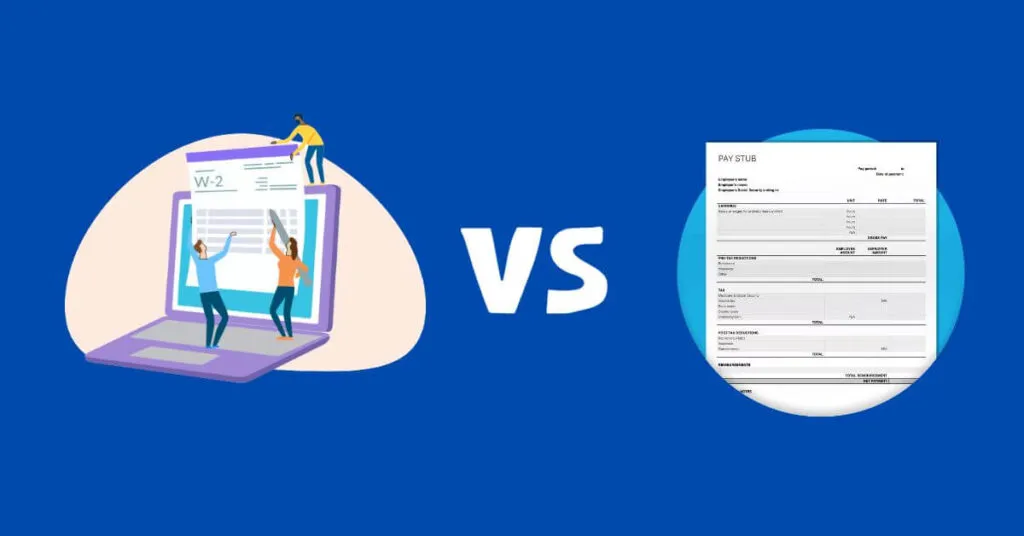Decoding Your Compensation: W-2 vs Pay Stub – Understanding the Nuances and Their Importance – This insightful article elucidates the key differences between W-2 forms and pay stubs, essential documents that outline employees’ earnings and tax withholdings. While both contain critical financial information, they serve distinct purposes and play unique roles in personal financial management and tax compliance.
The piece underscores the importance of these documents for various stakeholders, including employees, employers, and financial institutions, emphasizing their necessity for accurate tax filing, income verification, financial planning, and legal compliance. The article serves as a comprehensive guide, particularly for those keen on understanding the nuances of their compensation and maintaining robust financial health.
Understanding the complexities of employment documentation is crucial for both businesses and employees, particularly when it comes to financial records and compliance. Two documents that often create confusion are the W-2 form and pay stubs. Although they both relate to an employee’s compensation, they serve different purposes and contain various information. Let’s dissect these differences and discuss why it’s vital to understand both documents.
Table of Contents
What is a W-2?
A W-2 form is an annual tax document required by the Internal Revenue Service (IRS) in the United States. Employers are obligated to issue it for their employees, summarizing an employee’s earnings and withheld taxes throughout the previous year. These forms are indispensable for filing state and federal income taxes, and they must be sent out by employers by the end of January, giving employees ample time to prepare their tax returns before the deadline, typically on April 15.
Key components of a W-2 include:
1. Wages, tips, and other compensation
2. Federal income tax withheld
3. Social Security earnings
4. Medicare earnings
5. Additional tax withholdings, such as state and local taxes, retirement plan contributions, and more.
What is a Pay Stub?
In contrast, a pay stub is a document employees receive with each paycheck. It details their pay for that specific period, including wages, tax withholdings, and other deductions (e.g., for health insurance, retirement contributions, or wage garnishments). Pay stubs are ongoing employment records, giving a real-time snapshot of an employee’s earnings and deductions.
Common details found on a pay stub include:
1. Gross pay
2. Net pay
3. Federal and state tax deductions
4. Contributions for health insurance and retirement savings plans
5. Specifics about earned time off
W-2 vs. Pay Stub: Unraveling the Differences
Now, let’s delve into the primary distinctions between these two documents.
– Frequency and Usage:
– W-2 forms are annual statements provided for tax purposes. They consolidate an entire year’s worth of salary, wages, and applicable deductions. Employees use these forms to file their taxes, and they need to keep these documents for record-keeping requirements.
– Pay stubs are issued each time employees are paid, providing up-to-date information on their earnings and deductions. These records are crucial for budgeting, proving employment, or applying for loans.
– Content Specificity:
– W-2 forms offer a broad overview, summarizing annual earnings and taxes withheld. They don’t detail each payment cycle but instead give cumulative totals necessary for accurate tax filing.
– Pay stubs provide a breakdown of each pay period’s earnings and deductions, helping employees understand their compensation, track personal finances, and verify that they’re being paid correctly.
– Legal Requirements:
– Employers are legally required to provide W-2 forms to their employees and the SSA (Social Security Administration). Failing to do so, or providing inaccurate information, can lead to legal repercussions and financial penalties.
– The legal mandate around pay stubs varies by state. Some states require employers to provide pay stubs, while others do not. However, they are considered a best practice for transparency in the employer-employee relationship.
Why Does the Distinction Matter?
Understanding these documents’ differences is pivotal for several reasons:
1. Financial Awareness: Pay stubs help employees monitor their income and manage their finances, ensuring they’re paid correctly for their work and that the appropriate deductions are made.
2. Tax Obligations: The W-2 is a critical document for the tax filing process. It impacts an employee’s tax liability, potential deductions, and ultimately, the possibility of a refund. Mistakes on a W-2 can lead to tax return errors, potentially causing penalties or unwanted attention from the IRS.
3. Loan Applications & Major Purchases: Lenders often ask for copies of pay stubs as proof of income when individuals apply for loans, such as mortgages or car loans. Similarly, landlords may require them to verify a prospective tenant’s ability to pay rent.
4. Legal Compliance & Dispute Resolution: These documents can serve as vital evidence in situations like labor disputes over wages or child support cases. They are legal records of earnings and contributions.
5. Error Rectifications: Immediate access to pay stubs allows employees to spot discrepancies or errors. Conversely, an annual W-2 form helps confirm that the aggregated year-long information aligns with an employee’s records, ensuring accurate tax filing.
Conclusion: Embrace Financial Literacy
While they may seem like mundane pieces of paper, W-2 forms and pay stubs are financial roadmaps. Every number detailed is a fragment of the larger financial picture for employees, playing a critical role in understanding one’s compensation, tax strategy, and financial planning. For employers, issuing accurate and timely W-2s and pay stubs isn’t just a legal obligation; it’s a component of corporate responsibility and employee welfare.
In the intricate dance of income, taxes, and employment, knowledge is the currency of power. Whether you’re an employer, HR professional, or diligent employee, understanding these documents’ language can transform your approach to financial health and literacy, safeguarding you from potential pitfalls.


